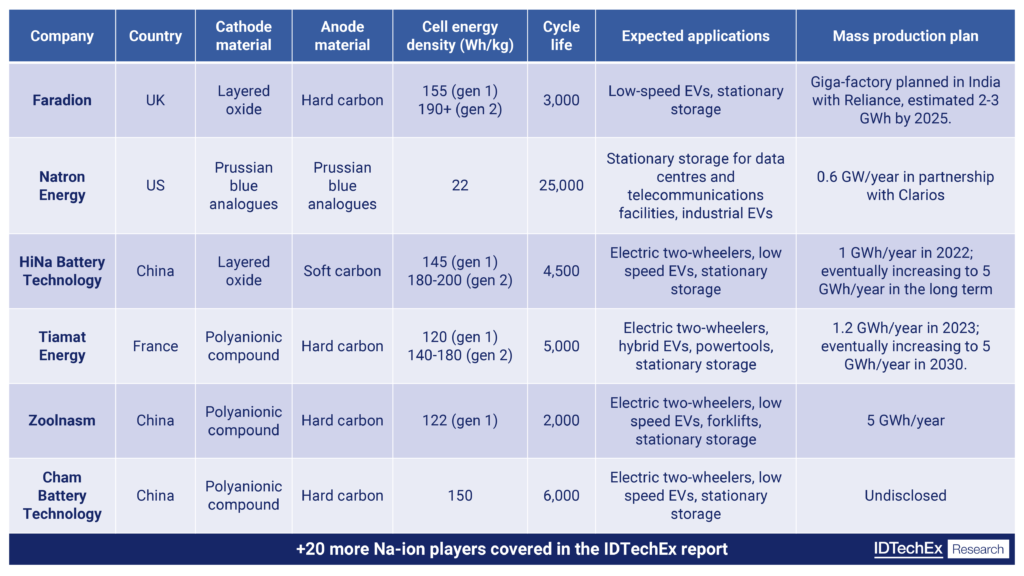What is the current market sentiment surrounding sodium-ion batteries in 2024?
Sodium-ion batteries are beginning to become increasingly relevant in 2024 after many mass production announcements were made in 2023. OEMs may look to alternative chemistries to reduce reliance on critical minerals with potentially volatile supply chains. NMC(A) batteries are currently the leading battery chemistry in Europe and the UK, while LFP dominates in China. However, LF(M)P and sodium-ion offer an opportunity to decouple from risk in certain supply chains. Market analysis in Nov 2023 by IDTechEx suggests an anticipated growth of approximately 40 GWh of SIBs alone by 2030 at a minimum. However, up to an additional 100 GWh of manufacturing capacity is projected if the market is successful by 2025. These projections assume an impending boom in the SIB industry, which will depend upon commercial commitment within the next few years.
Market leaders like CATL and BYD are the ones to watch out for as they can quickly bring online some serious sodium-ion supply capability. Their announcements have leapfrogged some European players as well. Despite lingering uncertainties about market prospects, companies in Western countries are now also making moves to enter the business, seeing the future potential of Na-ion batteries. The IDTechEx report, “Sodium-ion Batteries 2024-2034: Technology, Players, Markets, and Forecasts”, covers over 30 companies involved in this space and benchmarks their cells and/or their anode/cathode material.

Where does sodium fit into the battery market mix?
An opportunity does exist from a potential shortage of lithium supply in the medium term, given the lack of necessary investment into raw material extraction. While there is sufficient lithium resource to meet forecast demand from Li-ion before accounting for recycling, the capacity to mine this lithium has not grown at the necessary rate, offering an opportunity for alternative chemistries (e.g., Na-ion) in the medium and long term.
Furthermore, Na-ion is unlikely to replace the top-end of the Li-ion market. The two batteries will meet the application needs of different market segments, but Na-ion is expected to replace lead-acid (PbA) batteries in the future. Na-ion batteries are an attractive prospect in meeting global demand for carbon-neutral energy storage, where lifetime operational cost, not weight or volume, is the overriding factor. Stationary energy storage thus makes the perfect end-use and market for sodium, given its performance and safety characteristics.
Why hasn’t there been more of an uptake of sodium-ion batteries in recent times?
It’s worth noting that lithium carbonate prices have fallen sharply over the past year (2023) and could be potentially holding back the development of sodium-ion batteries. The cost advantage of sodium-ion batteries is seen to have diminished with the prolonged decline in the price of lithium carbonate, a key raw material for lithium-ion batteries. China hoped to bring sodium-ion batteries to mass market in 2023, but slumping lithium prices have cooled off investments and delayed or paused projects.
Furthermore, there is still no single-winning chemistry within sodium-ion batteries. Many R&D efforts are being undertaken to find the perfect anode/cathode active material that allows scalability beyond the lab stage. UL standardization for sodium-ion cells is, therefore, still a while away, and this makes OEMs hesitant to commit to such a technology.
What are the opportunities for sodium down the road?
Sodium-ion batteries still look promising for two and three-wheelers, microcars, and energy storage, even if the lithium price drop has slowed progress. Sodium-ion batteries are typically safer than lithium-ion and have higher resistance to low temperatures and relatively quick charging times. Sodium-ion batteries could replace lead-acid batteries in energy storage systems and the micro EV market. The costs will be competitive initially, but sodium-ion batteries will be lighter and safer than lead-acid batteries. Electric microcars with sodium-ion batteries are already being shipped from China. Specifically, 5,000 units of the E10X microcar (with 23.2 kWh sodium-ion battery packs using cells supplied by HiNa) from JAC Yiwei are being transported to Central and South America.
The IDTechEx report, “Sodium-ion Batteries 2024-2034: Technology, Players, Markets, and Forecasts”, provides in-depth coverage of this emerging industry and tackles many more burning questions.












